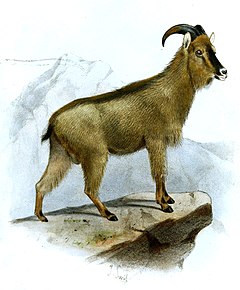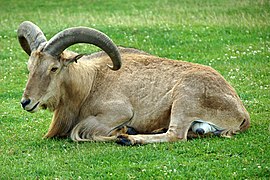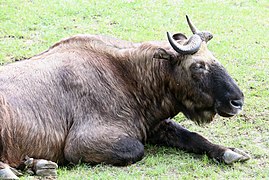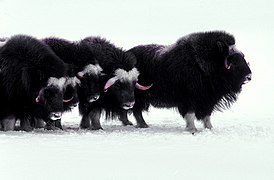Caprinae
Caprini · Caprinés, Caprins
| Règne | Animalia |
|---|---|
| Embranchement | Chordata |
| Sous-embr. | Vertebrata |
| Classe | Mammalia |
| Infra-classe | Eutheria |
| Ordre | Artiodactyla |
| Sous-ordre | Ruminantia |
| Infra-ordre | Pecora |
| Famille | Bovidae |
Les Caprinés (Caprinae) ou Caprins sont une sous-famille de Bovidés qui comprend notamment les chèvres, les moutons et les chamois.
Dans les nouvelles classifications, cette sous-famille devient la tribu Caprini au sens large.
Classification
[modifier | modifier le code]
On distingue plusieurs genres et espèces :
- Ammotragus Blyth, 1840.
- Ammotragus lervia (Pallas, 1777) — mouflon à manchettes
- Boötherium Leidy, 1852 (éteint)
- Boötherium bombifrons Harlan, 1825 — bœuf musqué casqué (éteint)
- Budorcas Hodgson, 1850.
- Budorcas taxicolor Hodgson, 1850 — takin.
- Capra Linnaeus, 1758 (chèvres et bouquetins).
- Capra aegagrus Erxleben, 1777 — chèvre sauvage, en Turquie, en Iran et dans le Caucase
- Capra aegagrus aegagrus
- Capra aegagrus creticus
- Capra aegagrus hircus Linnaeus, 1758 (ou Capra hircus) — chèvre domestique
- Capra caucasica Güldenstädt & Pallas, 1783 — chèvre du Caucase occidental
- Capra cylindricornis (Blyth, 1841) — chèvre du Caucase oriental
- Capra falconeri (Wagner, 1839) — chèvre du Cachemire ou markhor
- Capra ibex Linnaeus, 1758 — bouquetin des Alpes
- Capra nubiana F. Cuvier, 1825 — bouquetin de Nubie
- Capra pyrenaica Schinz, 1838 — bouquetin des Pyrénées
- Capra sibirica (Pallas, 1776) — yanghir
- Capra walie Rüppell, 1835 — bouquetin d'Abyssinie
- Capra aegagrus Erxleben, 1777 — chèvre sauvage, en Turquie, en Iran et dans le Caucase
- Hemitragus Hodgson, 1841 — tahrs.
- Hemitragus hylocrius (Ogilby, 1838) — tahr des Nilgiri.
- Hemitragus jayakari Thomas, 1894 — tahr d'Arabie.
- Hemitragus jemlahicus (H. Smith, 1826) — tahr de l'Himalaya ou jharal
- Naemorhedus Hamilton Smith, 1827 (serows).
- Naemorhedus baileyi Pocock, 1914 - bouquetin du Népal
- Naemorhedus caudatus (Milne-Edwards, 1867) - goral à queue longue
- Naemorhedus crispus (Temminck, 1845) - chèvre du Japon ou serow du Japon
- Naemorhedus goral (Hardwicke, 1825) - goral
- Naemorhedus sumatraensis (Bechstein, 1799) - serow
- Naemorhedus swinhoei (Gray, 1862) - chèvre de Taïwan
- Oreamnos Rafinesque, 1817.
- Oreamnos americanus (Blainville, 1816) — chèvre des Montagnes Rocheuses
- Ovibos Blainville, 1816.
- Ovibos moschatus (Zimmermann, 1780) — bœuf musqué.
- Ovis Linnaeus, 1758 (moutons et mouflons).
- Ovis ammon (Linnaeus, 1758) — mouflon méditerranéen, argali
- Ovis aries (Linnaeus, 1758) — mouton domestique
- Ovis canadensis Shaw, 1804 — mouflon canadien
- Ovis dalli Nelson, 1884 — mouflon de Dall
- Ovis nivicola Eschscholtz, 1829 — mouflon des neiges
- Ovis vignei Blyth, 1841 — urial
- Pseudois Hodgson, 1846 - bharal
- Pseudois nayaur (Hodgson, 1833) — grand bharal ou mouton bleu
- Pseudois schaeferi Haltenorth, 1963 — petit bharal
- Rupicapra Blainville, 1816
- Rupicapra pyrenaica Bonaparte, 1845 — isard
- Rupicapra rupicapra (Linnaeus, 1758) — chamois
-
Fossile de Bootherium
Phylogénie
[modifier | modifier le code]
Les Caprinae forment un clade des Aegodontia (bovidés à dents de chèvres). D'autres auteurs parlent de Caprini formant un clade des Antilopinae lato sensu. Phylogénie des Bovidés par tribus, d'après Calamari (2021)[1] :
|
Les caprinés résultent d'une rapide adaptation, il y a 11 Ma, à la vie montagnarde par réduction de leur métacarpes à la suite de leur isolement dans les montagnes du mégarchipel entre les mers Méditerranée et Paratéthys[2].
Leur rapide radiation explique la difficulté de définir un arbre phylogénétique précis des caprinés. On distingue clairement une lignée d'ovibovins rassemblant les genres Ovibos, Nemorhaedus et Capricornis, une autre d'ovins (genres Ovis et Nilgiritragus) dont les Budorcas[3] ou les Myotragus†[4] pourraient être un précurseur et enfin la lignée des chèvres (Pseudois, Hemitragus et Capra). En revanche, on n'arrive pas encore à placer de façon stable les genres Rupicapra, Ammotragus, Oreamnos ou Arabitragus.
| Caprinae |
| ||||||||||||||||||||||||
N.B. les positions phylogénétiques d'Ammotragus, Arabitragus, Oreamnos ou Rupicapra restent incertaines.
Relations internes de Caprinae basées sur l'ADN mitochondrial[5].
| |||||||||||||||||||||||||||||||||||||||||||||||||||||||||||||||||||||||||||||||||||||||||||||||||||||||||||||||||||
Voir aussi
[modifier | modifier le code]Références taxinomiques
[modifier | modifier le code]- (en) Référence Tree of Life Web Project : Caprinae
- (en) Référence Animal Diversity Web : Caprinae
- (en) Référence Catalogue of Life : Caprinae Gray, 1821 (consulté le )
- (fr + en) Référence ITIS : Caprinae Gray, 1821
- (en) Référence NCBI : Caprinae (taxons inclus)
Liens externes
[modifier | modifier le code]Notes et références
[modifier | modifier le code]- (en) Zachary T. Calamari, « Total Evidence Phylogenetic Analysis Supports New Morphological Synapomorphies for Bovidae (Mammalia, Artiodactyla) », American Museum Novitates, no 3970, , p. 1-38 (DOI 10.1206/3970.1)
- Anne Ropiquet et Alexandre Hassanin, 2004, Molecular phylogeny of caprines (Bovidae, Antilopinae): the question of their origin and diversification during the Miocene
- Jonathan D. Margot Molecular phylogeny of terrestrial artiodactyls. in The Evolution of Artiodactyls sous la direction de Donald R. Prothero et Scott E. Foss, 2007, (ISBN 978-0-8018-8735-2)
- Carles Lalueza-Fox et al., 2005, Molecular dating of caprines using ancient DNA sequences of Myotragus balearicus, an extinct endemic Balearic mammal.
- (en) Pere Bover, Bastien Llamas, Kieren J. Mitchell, Vicki A. Thomson, Josep Antoni Alcover, Carles Lalueza-Fox, Alan Cooper et Joan Pons, « Unraveling the phylogenetic relationships of the extinct bovid Myotragus balearicus Bate 1909 from the Balearic Islands », Quaternary Science Reviews, vol. 215, , p. 185–195 (DOI 10.1016/j.quascirev.2019.05.005, S2CID 189965070, lire en ligne)
Text is available under the CC BY-SA 4.0 license; additional terms may apply.
Images, videos and audio are available under their respective licenses.













